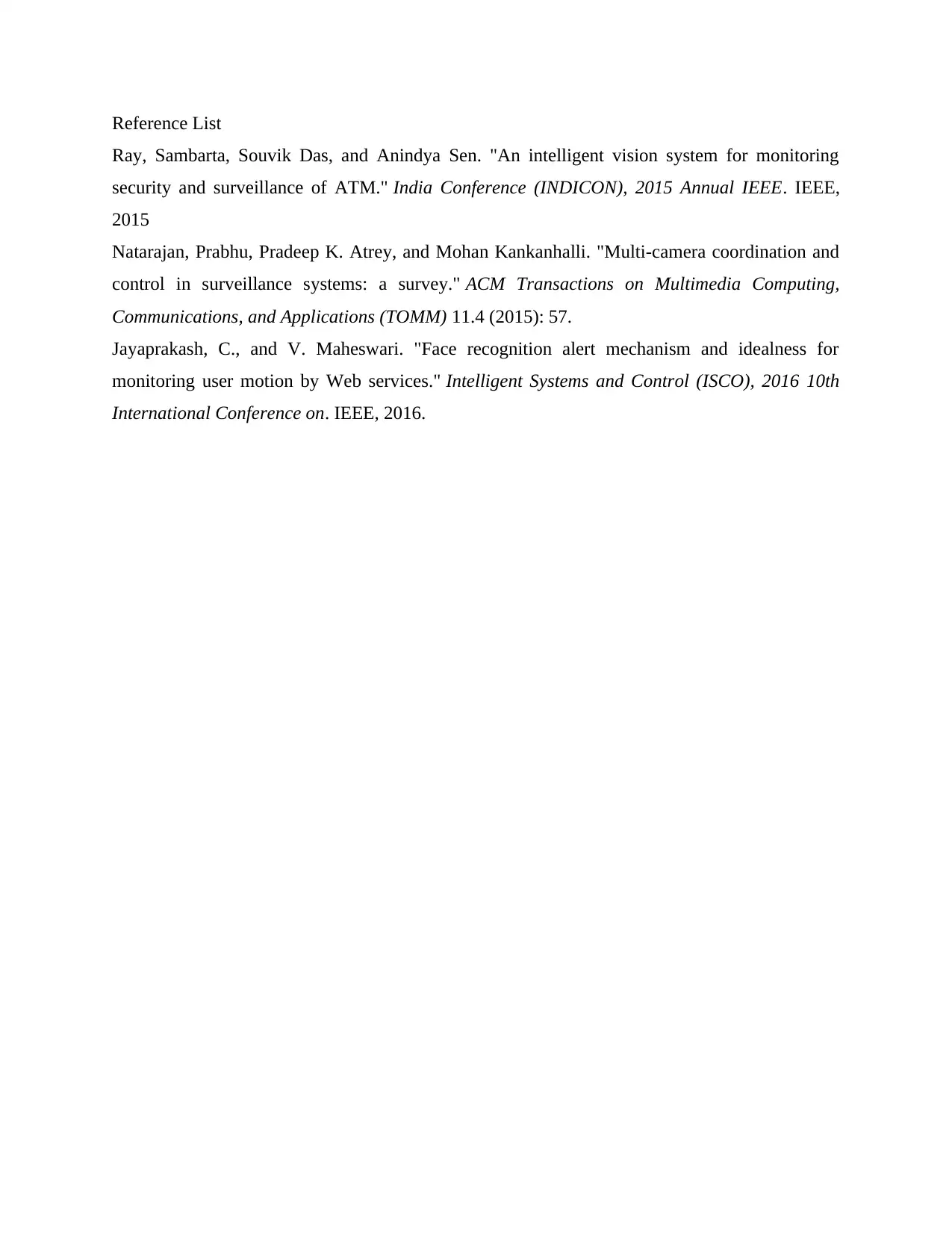ATM Camera Surveillance Report
VerifiedAdded on 2019/10/18
|5
|740
|334
Report
AI Summary
This report details the history of ATM camera technology, tracing its evolution from early 20th-century covert surveillance to modern systems incorporating facial recognition and digital multiplexing. It highlights the primary uses of ATM cameras, focusing on their role in preventing fraudulent activities like skimming and deterring threats to customers. The report argues for the inclusion of ATM camera footage in future digital public libraries, emphasizing the educational value for students and the potential for identifying patterns of criminal activity to improve security measures. The report concludes by suggesting that access to this data could lead to the development of more effective crime prevention strategies.

USE OF ATM CAMERAS
Paraphrase This Document
Need a fresh take? Get an instant paraphrase of this document with our AI Paraphraser

Table of Contents
History of ATM camera technology................................................................................................1
What is it used for............................................................................................................................1
Why moving images of ATM cameras should be included in future digital public library?..........2
History of ATM camera technology................................................................................................1
What is it used for............................................................................................................................1
Why moving images of ATM cameras should be included in future digital public library?..........2

History of ATM camera technology
It was not until the beginning of 20th century when surveillance across public areas became a
covert situation and it was first introduced in the UK. July 1994 saw the first use of covert CCTV
surveillance systems in the ATMs. Since the beginning of 20th, use of CCTV cameras increased
rapidly and it was time when Digital multiplexing was invented. It allows multiple cameras to
record at the same time and multiple digital systems can be combined in a shared system. The
1990s can be best described as the decade of CCTV use because commercially the device was
becoming much more viable (Ray 2015). The technological change in video surveillance has
been transforming after the attack on WTC. The hard drives contain the video footages can be
stored for a month but improvisation allows these moving images to be brightened or zoomed on
to detect any person. The signalling system in ATM machines has also been transformed after a
single surveillance system started to monitor the activities from different ATM sources. The
technology was becoming more mobile and facial recognition software was started to be
integrated into the cameras.
What is it used for
With increased invasion in privacy and fraud cases across the world, necessity to have a
surveillance activity has been increased. Primarily, ATM surveillance was intended to check on
movements of persons but arrangement of facial recognition software was used for identifying
and track any suspicious activities across ATM counters (Jayaprakash and Maheswari 2015).
Moving images and changing technologies allow to capture tiny details and with range of
functionalities. ATM surveillance can be very effective in prevention of fraudulent activities and
chances are getting lesser that customers are confronted with threatening at ATM areas. With
rise of technology, ATM skimming becomes an option to hack private data or PIN of ATM and
ATM camera can detect a skimming before it starts ever (Natarajan et al. 2015). The reason
behind use of ATM cameras is growing criminal activities and thieves are getting modern with
time; they sometimes use small hidden cameras to locate PIN but strong security system can
predict such activities and prevent them for occurrences. Most important use of ATM camera is
that the footage can be stored for a respective time and can be used for purpose in time. If the
cameras are IP-based, they can be achieved and later usable for any criminal investigation.
Searching through digital archive with specific time and date is relatively easy and the smooth
process helps ATMs left unattended for so many days.
It was not until the beginning of 20th century when surveillance across public areas became a
covert situation and it was first introduced in the UK. July 1994 saw the first use of covert CCTV
surveillance systems in the ATMs. Since the beginning of 20th, use of CCTV cameras increased
rapidly and it was time when Digital multiplexing was invented. It allows multiple cameras to
record at the same time and multiple digital systems can be combined in a shared system. The
1990s can be best described as the decade of CCTV use because commercially the device was
becoming much more viable (Ray 2015). The technological change in video surveillance has
been transforming after the attack on WTC. The hard drives contain the video footages can be
stored for a month but improvisation allows these moving images to be brightened or zoomed on
to detect any person. The signalling system in ATM machines has also been transformed after a
single surveillance system started to monitor the activities from different ATM sources. The
technology was becoming more mobile and facial recognition software was started to be
integrated into the cameras.
What is it used for
With increased invasion in privacy and fraud cases across the world, necessity to have a
surveillance activity has been increased. Primarily, ATM surveillance was intended to check on
movements of persons but arrangement of facial recognition software was used for identifying
and track any suspicious activities across ATM counters (Jayaprakash and Maheswari 2015).
Moving images and changing technologies allow to capture tiny details and with range of
functionalities. ATM surveillance can be very effective in prevention of fraudulent activities and
chances are getting lesser that customers are confronted with threatening at ATM areas. With
rise of technology, ATM skimming becomes an option to hack private data or PIN of ATM and
ATM camera can detect a skimming before it starts ever (Natarajan et al. 2015). The reason
behind use of ATM cameras is growing criminal activities and thieves are getting modern with
time; they sometimes use small hidden cameras to locate PIN but strong security system can
predict such activities and prevent them for occurrences. Most important use of ATM camera is
that the footage can be stored for a respective time and can be used for purpose in time. If the
cameras are IP-based, they can be achieved and later usable for any criminal investigation.
Searching through digital archive with specific time and date is relatively easy and the smooth
process helps ATMs left unattended for so many days.
⊘ This is a preview!⊘
Do you want full access?
Subscribe today to unlock all pages.

Trusted by 1+ million students worldwide

Why should moving images of ATM cameras be included in the future digital public
library?
The primary concept behind DPL is to make the access to digital important contents free for
public. It was designed to safeguard information and knowledge and information regarding
cultural heritage, museums and archives in the US. Catalogue of such incorporations is not yet
not finalized but inserting ATM camera’s moving images can be an aspiring one for students.
The public will come to know that they are relatively safe and suspicious activities are
monitored. More importantly, the moving images can help in identifying patterns of fraudulent
activities and new security measures can be established.
library?
The primary concept behind DPL is to make the access to digital important contents free for
public. It was designed to safeguard information and knowledge and information regarding
cultural heritage, museums and archives in the US. Catalogue of such incorporations is not yet
not finalized but inserting ATM camera’s moving images can be an aspiring one for students.
The public will come to know that they are relatively safe and suspicious activities are
monitored. More importantly, the moving images can help in identifying patterns of fraudulent
activities and new security measures can be established.
Paraphrase This Document
Need a fresh take? Get an instant paraphrase of this document with our AI Paraphraser

Reference List
Ray, Sambarta, Souvik Das, and Anindya Sen. "An intelligent vision system for monitoring
security and surveillance of ATM." India Conference (INDICON), 2015 Annual IEEE. IEEE,
2015
Natarajan, Prabhu, Pradeep K. Atrey, and Mohan Kankanhalli. "Multi-camera coordination and
control in surveillance systems: a survey." ACM Transactions on Multimedia Computing,
Communications, and Applications (TOMM) 11.4 (2015): 57.
Jayaprakash, C., and V. Maheswari. "Face recognition alert mechanism and idealness for
monitoring user motion by Web services." Intelligent Systems and Control (ISCO), 2016 10th
International Conference on. IEEE, 2016.
Ray, Sambarta, Souvik Das, and Anindya Sen. "An intelligent vision system for monitoring
security and surveillance of ATM." India Conference (INDICON), 2015 Annual IEEE. IEEE,
2015
Natarajan, Prabhu, Pradeep K. Atrey, and Mohan Kankanhalli. "Multi-camera coordination and
control in surveillance systems: a survey." ACM Transactions on Multimedia Computing,
Communications, and Applications (TOMM) 11.4 (2015): 57.
Jayaprakash, C., and V. Maheswari. "Face recognition alert mechanism and idealness for
monitoring user motion by Web services." Intelligent Systems and Control (ISCO), 2016 10th
International Conference on. IEEE, 2016.
1 out of 5
Related Documents
Your All-in-One AI-Powered Toolkit for Academic Success.
+13062052269
info@desklib.com
Available 24*7 on WhatsApp / Email
![[object Object]](/_next/static/media/star-bottom.7253800d.svg)
Unlock your academic potential
Copyright © 2020–2025 A2Z Services. All Rights Reserved. Developed and managed by ZUCOL.



